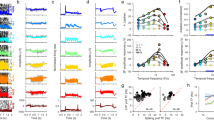Abstract
The activity of cortical neurons is influenced by retinal stimulus location and temporal modulation. We investigated how reversal frequency of black-and-white checkerboard patterns presented in different parts of the visual field affects evoked potential topography. Visual evoked potentials were recorded from an array of 16 electrodes over the occipital cortex in 12 healthy adults. A checkerboard reversal stimulus (40′ check size) was presented with frequencies between 1.95 reversals/s and 7.81 reversals/s in the center or in the left or right hemiretina. Evoked potential fields displayed the well-known components of pattern reversal evoked activity. Computation of FFT and wavelets displayed electrical brain responses directly related to stimulation frequency. Further analysis showed that both retinal stimulus location and stimulation frequency affected visual evoked activity. Field strength as well as scalp field topography changed significantly with different reversal frequency. In addition, the pattern of lateralization of components also depended on temporal frequency of stimulation.Electrical brain activity elicited by visual stimuli shows globally similar features which are modulated by stimulus location and frequency. Our results indicate that—at least partly—different neuronal assemblies are activated by stimuli of different temporal characteristics.
Similar content being viewed by others
References
Brown JL. Flicker and intermittent stimulation. In: Graham CH, editors. Vision and visual perception, John Wiley & Sons, New York; 1965. p. 251–320.
Campbell FW, Maffei L. Electrophysiological evidence for the existence of orientation and size detectors in the human visual system. J Physiol 1970;207:635–52.
DiRusso F, Pitzalis S, Aprile T, Spitoni G, Patria F, Stella A, Spinelli D, Hillyard SA. Spatio-temporal analysis of the cortical sources of the steady-state visual evoked potential. Human Brain Mapping 2007;28:323–34.
Eysel UT, Burandt U. Fluorescent tube light evokes flicker responses in visual neurons. Vision Res 1984;24:943–8.
Heine M, Meigen T. The dependency of simultaneously recorded retinal and cortical potentials on temporal frequency. Doc Ophthalmol 2004;108:1–8.
Lehmann D, Skrandies W. Reference—free identification of components of checkerboard—evoked multichannel potential fields. Electroenceph clin Neurophysiol 1980;48:609–21.
Müller MM, Teder W, Hillyard SA. Magnetoencephalographic recording of steadystate visual evoked cortical activity. Brain Topogr 1997;9:163–8.
Nakayama K, Mackeben M. Steady state visual evoked potentials in the alert primate. Vision Res 1982;22:1261–71.
Regan D. Assessment of visual acuity by evoked potential recording:ambiguity caused by temporal dependence of spatial frequency selectivity. Vision Res 1978;18:439–43.
Schmolesky MT, Wang Y, Hanes DP, Thompson KG, Leutgeb S, Schall, JD, Leventhal AG. Signal timing across the macaque visual system. J Neurophysiol 1998;79:3272–8.
Skrandies W. Critical flicker fusion and double flash discrimination in different parts of the visual field. Intern J Neuroscie 1985;25:225–31.
Skrandies W. Visual persistence of stereoscopic stimuli:electric brain activity without perceptual correlate. Vision Res 1987;27:2109–18.
Skrandies W. Brain mapping of visual evoked activity—topographical and functional components. Acta Neurol Taiw 2005;14:164–78.
Skrandies W, Jedynak A. Learning to see 3-D: psychophysical thresholds and electrical brain topography. NeuroReport 1999;10:249–53.
Skrandies W, Raile A. Cortical and retinal refractory periods in human visual system. Intern J Neuroscie 1989;44:185–95.
Srinivasan R, Bibi FA, Nunez PL. Steady-state visual evoked potentials: distributed local sources and wave-like dynamics are sensitive to flicker frequency. Brain Topogr 2006;18:167–87.
Vafaee MS, Meyer E, Marrett S, Paus T, Evans AC, Gjedde A. Frequency-dependent changes in cerebral metabolic rate of oxygen during activation of human visual cortex. J Cereb Blood Flow Metab 1999;19:272–7.
Acknowledgement
Supported by Deutsche Forschungsgemeinschaft, DFG (SK 26/8-3)
Author information
Authors and Affiliations
Corresponding author
Rights and permissions
About this article
Cite this article
Skrandies, W. The Effect of Stimulation Frequency and Retinal Stimulus Location on Visual Evoked Potential Topography. Brain Topogr 20, 15–20 (2007). https://doi.org/10.1007/s10548-007-0026-1
Accepted:
Published:
Issue Date:
DOI: https://doi.org/10.1007/s10548-007-0026-1




